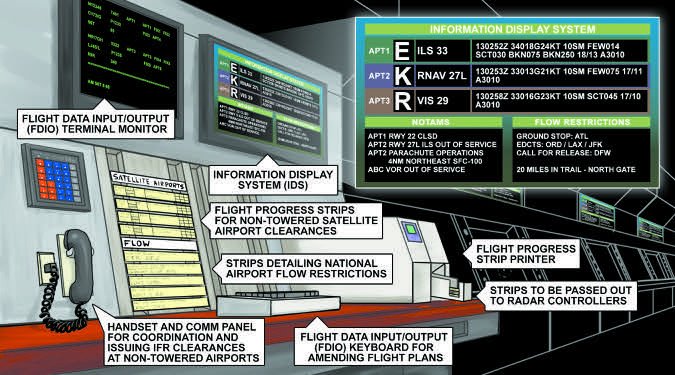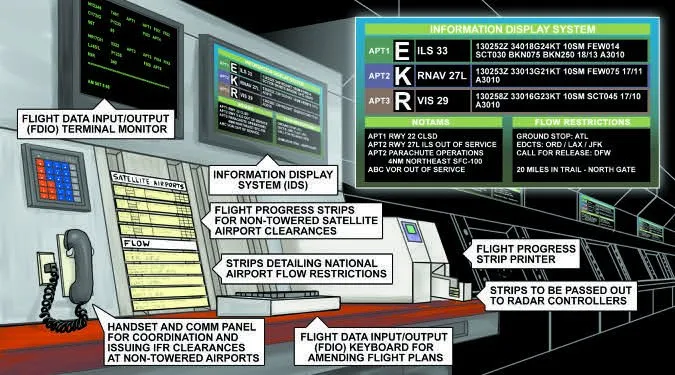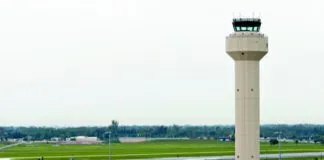My wife and I had a friend over for dinner. Our conversation eventually landed on our respective jobs. It had been storming non-stop all afternoon, making my life in the radar room a huge vector-filled headache. I mentioned that we’d had a lot of flights divert because of the awful weather.
With genuine concern, our friend asked, “Were you okay working outside, with the rain and all?” I paused, a forkful of food in hand. Then it hit me. She’d always thought air traffic controllers were the marshallers with the orange wands, waving airplanes to parking.
After all, at a glance by the public, the only folks on an airport telling planes where to go seem to be those hardy rampers who work in all kinds of miserable conditions. Meanwhile, air traffic controllers tend to be invisible, tucked away in towers and radar rooms. The flying public might not know they even exist.
Pilots, of course, know better. You’ve spoken with myriad controllers, each providing a specific service—Clearance Delivery, Ground, Tower, Approach, Center. Their efforts are tangible to you.
But, inside Approach Control, there’s another controller with whom you may rarely—or perhaps even never—communicate. This often-unappreciated individual is integral to the ATC operation as a whole, and the management of your flight in particular. Who is this mysterious individual? It’s the Flight Data Controller.
Delegation of Duty
A radar controller’s primary concern is the safe sequencing of airplanes. Accomplishing this requires more than just good judgment, clear communication, effective working speed, and knowledge of aircraft and airspace. It depends also on up-to-date information and the ability to stay focused on his airplanes.
The controller needs access to a variety of data, such as weather, NOTAMs, nationwide flow restrictions, PIREPs. SIGMETs, etc. This (often critical) information changes frequently, comes from a variety of different sources, and affects aircraft in a many ways.
And all that is just general situational awareness. Dozens of aircraft could depart, arrive, or traverse an approach controller’s airspace every hour. But before each makes their first radio call, the controller must be aware of its route, altitude, and aircraft type. There are also clearances to be issued at other airports, and changes to flight plans. This can be time-consuming and distract the controller from the aircraft in his airspace.
All this can be a handful to manage. So, many approach facilities (and others, see sidebar) staff a position in the radar room specifically intended to manage all of this—wait for it—flight data. This imaginatively-named Flight Data position takes a load off the radar controllers.
The position itself is typically a desk with a variety of equipment and control panels. There’s typically a com panel they use to talk with the other positions in the facility, other facilities and to work Clearance Delivery frequencies. Flight Data’s task is information management. Every tool at their disposal is intended for the sharing and display of that data.
The person working Flight Data is typically just one of the controllers in the facility. Some ATC facilities used to hire Air Traffic Assistants for Flight Data, freeing up controllers, but ATAs are far less common these days. Flight Data is just one of several positions a controller might work. For instance, I might be working a radar position, but after my break, I might jump on Flight Data.

Graphics by the author
Plane Progression
The Flight Data controller’s primary task is disseminating flight plans. While society at large moves towards a “paperless” environment, that’s not the case for many approach radar facilities. Whenever an aircraft is expected to come in contact with our airspace, its flight plan will print on a narrow piece of thermal paper called a Flight Progress Strip (FPS.)
Every FPS contains essential flight information—call sign, aircraft type and suffix, requested altitude, and route—vital for the radar controller’s situational awareness and decision-making. The other information on it changes depending on whether the aircraft is departing, arriving, or merely passing through.
The depiction of time and geographic fixes varies between FPSes. A departure strip displays both the flight’s proposed takeoff time, and airport. In contrast, arrival and overflight strips each depict the geographic fix where the aircraft is expected to enter the facility’s airspace, and the time it’s estimated to do so. Each strip prints out half an hour before the departure or entry time.
Most facilities have multiple sectors, each covering different geography and altitudes. As each strip prints, Flight Data places it at the first sector that’ll be working that flight. This requires a working knowledge of our airspace—including all airways, fixes, navaids, and airports—and our traffic flow agreements with neighboring facilities. Our airspace also shifts drastically depending on which runways our airports are using; getting the strip to the right place is critical.
Of course, flight plans also change. As a flight continues towards our airspace, every route or altitude change issued elsewhere translates into an amended strip printed out here. The old strip at the sector must be replaced with the updated one. One flight with six amendments produces seven strips: the original, plus the six altered ones. That’s seven trips to the affected radar scope, and a whole lot of exercise for the Flight Data controller.
Of course, our own radar controllers might also ask Flight Data to amend flight plans for changing airspace conditions, weather deviations, or pilot requests. Changes are shouted across the room or called in through the voice panel. We use our specialized Flight Data Input Output computer to change altitudes, routes, destinations, remarks, and more. Other facilities further down the route will then get those same amendments.
On busy days, the radar controllers aren’t the only thing buzzing. Our FPS printer is spitting out strips constantly and the amendment requests are flying. It takes serious speed and accuracy to keep up with it. If a swamped controller doesn’t have the flight plan info readily available, it can cause a distraction, which in turn can lead to other problems. At times like these, we might staff multiple Flight Data positions, segmenting responsibilities.
Clearing House



Flight Data can also issue IFR clearances to aircraft on the ground at nearby nontowered airports. Like every airport, every ATC facility is different. At some, the listed Clearance Delivery frequency for nontowered airports is worked by the radar controller overseeing that field. Others give Flight Data that responsibility.
If you call Clearance Delivery on the ground at a nontowered field, and hear a controller handling airborne aircraft, well, that’s a radar controller. On the other hand, if you hear nothing until you request your IFR clearance (or, just other clearances being issued), you’re probably talking to a Flight Data Controller. They’ll often answer the frequency “[Approach control’s name] clearance.”
At our facility, Flight Data handles the satellite airports. We keep the flight progress strips for all nontowered airport departures at the Flight Data console and monitor the relevant clearance frequencies. When you call for your clearance, the Flight Data controller grabs your strip, issues your clearance, and tells you to hold for release. After verifying your readback, you’re typically asked to report number one at the runway and ready to go, and advise which runway you’ll be departing. The latter factors into what heading you’ll be assigned on the go.
When you call ready, Flight Data tells you to standby, and physically takes your flight plan over to your departure radar controller, and tells him, “[Call sign] is ready to go off [runway] at [airport].” If there’s no conflicting IFR traffic, the radar controller gives Flight Data your void time (if necessary, based on other traffic), heading and possibly a different initial altitude. The Flight Data controller then returns to his console and relays that information to you with your release.
As with many Flight Data duties, this eases the radar controller’s load. There are many steps to a clearance from a nontowered airport. We just ask that you be patient. If the radar controller is saturated with traffic, it can take some time before he can work you in. The process is the same if you request your clearance through Flight Service, but it takes longer with another person in between.
In the Loop
Remember how I mentioned all that general situational awareness stuff earlier? We need to stay on top of that too. Every radar control position has an Information Display System (IDS) screen displaying the latest relevant airspace, weather, and flow information.
An approach control will typically display the ATIS code, METAR/SPECI, and NOTAMs for its largest airports. Depending on our letters of agreement with those fields, their tower may call in any changes verbally or transmit them to us electronically. Flight Data then types that into our IDS. Sometimes—if they’re lucky—a tower and Approach’s IDS are linked, so when the tower updates theirs, it automatically appears on our screens. However the info gets to our IDS, when you check in with Approach and say you have the ATIS, the radar controller is cross-checking it with what’s displayed.
What about “bigger picture” weather? Our FDIO printer isn’t just for flight plans. It also cranks out SIGMETs, Center Weather Advisories, and urgent PIREPs. Flight Data takes each report, verifies that it applies to our airspace, and sends it to the radar controllers, who read it out on frequency to their traffic. Plus, we get a daily flight service call with the TAF, which must be added to the IDS.
We must also deal with national traffic flow programs from the ATC System Command Center in Virginia, and the En Route Air Traffic Control Centers. When one major airport gets backed up, any airport sending traffic their way is affected. This can happen thanks to weather, airline computer problems, ATC equipment issues, aircraft incidents, planned construction, or—and I’ve seen it happen—any combination of the above.
These flow programs may take the appearance of EDCT (Expect Departure Clearance Times) or CFR (Call For Release) requirements, where departing aircraft are given specific times to depart, spreading their impact out a bit. A center can also impose miles-in-trail restrictions, where—instead of the usual five miles between IFR aircraft—they can demand that Approach feeds them aircraft spaced by 15 miles, 20 miles, or even more. Depending on the problem’s severity, they may even “ground stop” all aircraft headed to that airport, preventing further departures.
All of this info must be readily accessible and disseminated to everyone affected by it. Many times they’ll be called in by Center on a landline. Other times, flow notices will come off the printer. Regardless of the source, Flight Data must still type everything into the IDS for the radar controllers to see. Depending on the situation—for instance, a miles-in-trail restriction, which is normally just a verbal notice—it’s sometimes necessary to call the towered airports in the vicinity and let them know.
Flight Data isn’t a glamorous position. There’s plenty of frantic running around, data entry, and communication (much of it people yelling at you for amendments). People both inside the room and out are clamoring for your attention. It often feels like you’ll never catch up. However, you can’t fall behind, or it’s going to bring down the rest of the radar room. The Flight Data controller might be nearly invisible to pilots, but their efforts aren’t. That in itself is enough motivation to keep fighting the good fight.
The Many Forms of Flight Data
I’ve mostly been talking about Flight Data’s operation inside an approach control. Towers and centers also require controllers to manage flight plan info, weather, and the rest. However, they’re delegated differently.
In a control tower, the Flight Data position is often combined with Clearance Delivery. It fulfills many of the same functions as the approach control’s FD, such as examining and amending flight plans, updating NOTAMs on our screens, displaying traffic flow programs, and passing out convective SIGMETs, PIREPs, and Center Weather Advisories.
It also has some tower-specific tasks. First, is recording the ATIS. Tower FD is responsible for monitoring the ASOS (Automated Surface Observation System) and verifying it’s providing good weather information. Additionally, they are typically responsible for contacting the emergency equipment on the field. When faced with weather or airspace restrictions, they may coordinate flight reroutes and general traffic flow with Center and Approach.
En Route Air Traffic Control Centers operate differently. Where towers and approach controls require a Flight Data Input/Output computer to amend and update flight progress strips, Centers do not. Their controllers can amend flight plans directly at their more feature-rich consoles. As one center controller I know put it, “We are the FDIO.” Centers also don’t use strips nearly as much anymore, having replaced them with electronic flight plan displays.
They do staff a position called an A-side—often a trainee—who performs the remaining odd jobs. For example, areas with no radar coverage still heavily rely on strips, since there are no targets to track electronically. The A-side will manage the printer, assist with nontowered clearances, pass out weather updates, and provide support where needed. They’re also the poor fellow most likely to get “voluntold” to make chow runs…





